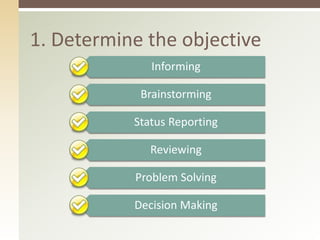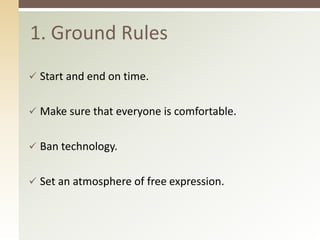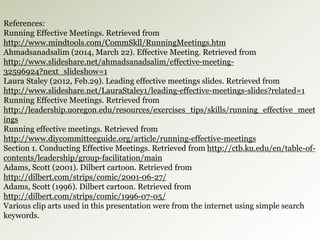Running effective meetings
- 1. RUNNING EFFECTIVE MEETINGS Rizzie Enriquez
- 2. Purpose and Objectives Know the components of an effective meeting To be able to run an effective meeting
- 4. Components
- 5. Determine the objective. Prepare the agenda. Make meeting room reservations. Send invitations. Before the Meeting
- 6. 1. Determine the objective Informing Brainstorming Status Reporting Reviewing Problem Solving Decision Making
- 7. 2. Prepare the agenda. Time
- 8. 3. Make reservations. Size of the team. Room set up.
- 9. 4.Send invitations. Email/Outlook Agenda Advance reading Response
- 10. During the Meeting Ground Rules Effective Chairing
- 11. 1. Ground Rules Start and end on time. Make sure that everyone is comfortable. Ban technology. Set an atmosphere of free expression.
- 12. 2. Effective Chairing Follow the agenda. Park questions that are off topic. Purpose and summary. Next steps.
- 14. Meeting has a process. Follow the process but never overdo it.
- 15. If you want to go back to this presentation, you can go to slideshare. http://www.slideshare.net/GoGetterPM
- 16. Thank you!
- 17. References: Running Effective Meetings. Retrieved from http://www.mindtools.com/CommSkll/RunningMeetings.htm Ahmadsanadsalim (2014, March 22). Effective Meeting. Retrieved from http://www.slideshare.net/ahmadsanadsalim/effective-meeting- 32596924?next_slideshow=1 Laura Staley (2012, Feb.29). Leading effective meetings slides. Retrieved from http://www.slideshare.net/LauraStaley1/leading-effective-meetings-slides?related=1 Running Effective Meetings. Retrieved from http://leadership.uoregon.edu/resources/exercises_tips/skills/running_effective_meet ings Running effective meetings. Retrieved from http://www.diycommitteeguide.org/article/running-effective-meetings Section 1. Conducting Effective Meetings. Retrieved from http://ctb.ku.edu/en/table-of-contents/ leadership/group-facilitation/main Adams, Scott (2001). Dilbert cartoon. Retrieved from http://dilbert.com/strips/comic/2001-06-27/ Adams, Scott (1996). Dilbert cartoon. Retrieved from http://dilbert.com/strips/comic/1996-07-05/ Various clip arts used in this presentation were from the internet using simple search keywords.
Editor's Notes
- GREETINGS 1. Name 2. Topic 3. Set expectations – state the overview – Can you hear me okay in the back? 4. Let’s get started. Distribute the handout.
- As PMs, this presentation aims to equip you to better chair meetings as project leaders. Meetings used to be important and they used to be happening a lot in organizations. Until they became boring and useless. In agile software development processes, they have “stand up” meetings which aim to be short while still providing real-time status reporting.
- We hold meetings too often and often for the wrong reasons, too.
- Just read the components one by one. Each of these components will be discussed in detail in the next slides. These components overlap in organizing, chairing, tracking the meeting. We will discuss the steps a manager, esp. a PM, need to take before the meeting, during the meeting and after the meeting.
- Just read one by one. How do we determine the objective?
- The objective will determine who you will invite to attend the meeting so how many people are attending, do we need to send documents in advance so they can read these documents before we ask for their vote or decisions, what materials or equipment we need to have for the meeting. Informing – is there a new memo, a change in the charter? This is a simple meeting where we just need to relay information and maybe open the floor for some questions. It is important that you give them a document so they can also prepare their concerns or questions. Brainstorming – one project management tool that is used for project planning is sticky notes Status Reporting – when people attending your status reporting know that they are expected to provide an update on where they are with their tasks, they will come prepared and it will be one productive meeting. Reviewing – It can be a follow up meeting where all action items from the previous meeting will be discussed. It can also be a meeting where we will discuss the overall health of the project if we are in the brink of recommending its termination. Problem Solving – Project management is for problems so if there is a problem that needs to be resolved, a meeting can be conducted. Decision Making – I suggest cancelling the meeting if an important decision maker is not going to attend.
- Remember that when you create the agenda, you put your allotted time in each of them to better guide your participants.
- Based on your objective, you will be able know the right kind of room based on capacity which you need to reserve. If it is a decision-making meeting, it usually needs to be in a U-shaped room so people face each other.
- People check their emails more than they answer their phones or read what’s on the bulletin board so send your invitation via email. Better if your office uses Outlook, it will automatically add the event in their calendar, block it and remind them about the meeting. Make sure that you attach the agenda in your email invitation. Inform them that you are providing copy but they are free to bring their own notes if they need to. If there is any document that needs to be read in advance, send it. This will lower the chance of people not participating because they don’t know what’s going on and increase the chance of people taking a stand in a decision-making meeting. Lastly, make sure that you encourage people to respond with a yes, suggest a new meeting time/date, or even more important if a no. Reschedule without critical staff.
- During the meeting, make sure that you inform the participants of what you expect to happen while the meeting is ongoing. It is your ability to chair the meeting effectively that will help you reach the goal of your meeting, whether or not they will be showing up on your next meeting or getting their buy ins.
- Start on time. If you say 8:00 in your agenda, start at 8:00. Make sure that everyone is comfortable. Survey the room when you get in, make sure it is not too cold or there are enough chairs so everyone can sit down. Exchange pleasantries in the beginning. It is important to allot 5 minutes for everyone make brief introductions or say hello- get a little informal because when the meeting starts, it will be formal. Ban technology. If at all possible, your laptop where the presentation will be should be the only laptop in the room, politely remind them to turn off their mobile devices. Set an atmosphere of free expression to encourage full participation. Do not take sides and do not disregard a question. Always refer to the group’s consensus whether a question should be addressed/answered or should it be parked.
- Make sure that someone is taking down notes in your meeting. In the past, everyone gets a chance to be a note taker. It is also an exercise for people to develop their listening and writing skills. Follow the agenda. It is your agenda so follow it. It will provide the structure of the meeting. When the group agrees that a question should be parked, take note and move forward. Interventions attempt to be low on the confrontation scale but still are effective in getting disrupters under control. Those who don’t share airtime. Preventions are techniques that can help you avoid disruption from the start. Restate your purpose and summarize the meeting so you can measure which ones you have accomplished from the agenda of the meeting. Inform participants of next steps.
- The meeting does not end when the last person in the room leaves. If you promised the minutes of the meeting, send it. Make sure that you address or answer the parked questions. It can determine if you need to schedule a follow up meeting. If possible, include the answers to the parked questions in your minutes of the meeting. Be accountable for the action items from the meeting. If you don’t follow up with people, they will wait until you call for another meeting before they do their part. Send them the signal that items discussed in meetings are big deal. Evaluate the value of the meeting. A good measure comes down to money. Was the staff better off staying in their desk working?
- Summary Let’s see what Dilbert has to say about this. READ the sentences only.
- Hope you are now more ready and confident to run an effective meeting.

















